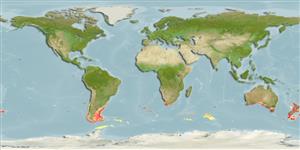Cephalopoda |
Oegopsida |
Ommastrephidae | Todarodinae
Environment: milieu / climate zone / depth range / distribution range
Ecology
Pelagic; depth range 0 - 500 m (Ref. 275), usually 200 - ? m (Ref. 275). Polar; 32°S - 64°S, 180°W - 180°E (Ref. 275)
Circumpolar in Southern Ocean; south of approximately 35°S, Antarctic Convergent zone.
Length at first maturity / Size / Weight / Age
Maturity: Lm ? range ? - ? cm Max length : 55.5 cm ML male/unsexed; (Ref. 122358)
Common mantle length: 20.0-40.0 cm. Common mantle length ranges between 20 and 40 cm (Ref. 3722). Possesses strongly developed positive phototaxis (Ref. 275).
Life cycle and mating behavior
Maturity | Reproduction | Spawning | Eggs | Fecundity | Larvae
Members of the class Cephalopoda are gonochoric. Male and female adults usually die shortly after spawning and brooding, respectively. Mating behavior: Males perform various displays to attract potential females for copulation. During copulation, male grasp the female and inserts the hectocotylus into the female's mantle cavity where fertilization usually occurs. Life cycle: Embryos hatch into planktonic stage and live for some time before they grow larger and take up a benthic existence as adults.
Roper, C.F.E., M.J. Sweeney and C.E. Nauen 1984 FAO Species Catalogue. Vol. 3. Cephalopods of the world. An annotated and illustrated catalogue of species of interest to fisheries. FAO Fish. Synop. 125(3):277p. Rome: FAO. (Ref. 275)
IUCN Red List Status
(Ref. 130435: Version 2025-1)
CITES status (Ref. 108899)
Not Evaluated
Not Evaluated
Threat to humans
Human uses
Fisheries: commercial
| FishSource |
Tools
More information
Trophic EcologyFood items (preys)Diet compositionFood consumptionPredators Population dynamicsGrowthMax. ages / sizesLength-weight rel.Length-length rel.Length-frequenciesMass conversionAbundance Life cycleReproductionMaturityFecunditySpawningEggsEgg developmentLarvae PhysiologyOxygen consumption
Human RelatedStamps, coins, misc.
Internet sources
Estimates based on models
Preferred temperature
(Ref.
115969): 4.7 - 13.5, mean 10.3 (based on 16 cells).
Fishing Vulnerability
Moderate vulnerability (42 of 100).
